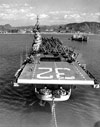|
|
|
|
| Missing In Action (MIA) | Prisoners Of War (POW) | Unexploded Ordnance (UXO) |
| Chronology | Locations | Aircraft | Ships | Submit Info | How You Can Help | Donate |
|
| USN Essex-class aircraft carrier 27,100 Tons (standard) 888' x 93' x 28' 7" 4 x Twin 5" guns 4 x 5" guns 8 x Quad 40mm AA 46 x 20mm AA 90-100 aircraft  USN c1950  USN November 1950  USN December 1, 1950  USN February 3, 1951 |
Ship History Built by Newport News Shipbuilding and Dry Dock Company in Newport News, Virginia. Laid down February 21, 1944. Launched August 23, 1945 as USS Leyte named in honor of Battle of Leyte Gulf sponsored by Mrs. James M. Mead. Commissioned April11, 1946 in the U.S. Navy (USN) with Captain Henry F. MacComsey in command. During autumn of 1946, Leyte and battleship Wisconsin made a good will cruise down the western coast of South America, then to the Caribbean on arriving on November 18, 1946 for her shakedown cruise. During 1948, Leyte was equipped with a detachment of Sikorsky HO3S-1 helicopters. Participated in "Operation Frigid" fleet exercises in the North Atlantic. Next the carrier deployed to the Mediterranean during April–June 1947 then again July–November 1947, September 1949 until January 1950. During May 1950 departed Quonset Point, Rhode Island on her fourth Mediterranean cruise. On August 13, 1950 her aircraft made a demonstration of air power over Beirut, Lebanon to deter Communist pressure in the Middle East. Afterwards, Leyte returned to Norfolk on August 24 and underwent fifteen days of of preparation for deployment in support of United Nations forces in Korea. On September 6, 1950 Leyte departed Norfolk via the Panama Canal and San Diego, joining Carrier Air Group 3 (CAG-3) and Task Force 77 (TF-77). Aboard were squadrons VF-31 "Tomcatters", VF-33 "Tarsiers" operating the F8F Bearcat and F4U Corsair, VC-62 "Fighting Photo" operating the F4U-5P Corsair and VF-32 "Swordsmen" operating the F4U Corsair, including the first African-American Naval aviator, Ensign Jesse LeRoy Brown. Korean War After crossing the Pacific, arrived at Sasebo on October 8, 1950 and departed the following day for operations off Korea. Over Korea, her fighters claimed one of the the first MiG-15 kills. On December 1, 1950 was anchored at Yokosuka for a brief break from operations before returning to station off the Korean peninsula. On December 4, 1950 six Corsairs from VF-32 took off on a strike mission over the Chosin Reservoir (Changjin). Over the target, F4U Corsair 97231 piloted by Ensign Jesse LeRoy Brown crash lands and wingman F4U Corsair 82050 piloted by Lt(jg) Thomas J. Hudner crash landed beside him in an attempt to rescue his flight leader. Brown was pinned in the cockpit and he was unable to free him but spoke with Brown until he expired. Later, Hudner was rescued by helicopter and returned to duty. In total, between October 9, 1950 until January 19, 1951 Leyte was at sea 92 days and her aircraft flew 3,933 sorties, her pilots accumulated 11,000 hours in the air. Leyte earned two battle stars for her service during the Korea War. Afterwards, Leyte departed the Pacific via San Diego then returned to Norfolk on February 25, 1951 for overhaul then participated in fleet exercises in the Caribbean until August 21, then another tour of duty with the 6th Fleet on September 3. Afterwards to Norfolk on December 21 and then departed for the Mediterranean on August 29, 1952. On October 1, 1952 reclassified as an attack carrier, CVA-32 and returned to Boston on February 16, 1953 for deactivation. Instead, retained in active service and on August 8 began conversion at Boston into an anti-submarine aircraft carrier, redesignated CVS-32. On October 16, 1953 at 15:15 an explosion in her port catapult machinery room caused a fire that resulted in the death of 37 and 28 injured. The fire was extinguished by 19:57. Completed on January 4, 1955 Leyte departed for Quonset Point, Rhode Island as flagship of Carrier Division 18 (CarDiv 18). Until 1959, conducted anti-submarine warfare operation off the eastern coast of the United States and Caribbean, operating from Quonset Point. During January 1959 departed Quonset Point for the New York Navy Yard for preinactivation overhaul and was redesignated AVT-10 and decommissioned on May 15, 1959. Assigned to the Philadelphia group of the Atlantic Reserve Fleet. During September 1970, sold for scrap. References U.S.S. Leyte (CV-32) 4 December 1950, page 5 "1515I an F4U4 BUNO. 97231 crash landed in Korea behind enemy lines at lat. 40 degrees 36N, long 127 degrees 06' E. Cause: Enemy anti-aircraft hits. Pilot ENS J. L. Brown, 504477, U.S. Navy, sustained severe injuries and was unable to extricate himself. LtJG T. J. Hudner, Jr., 485270, U.S. Navy, landed hit F4U4 (BuNo. 82050), wheels up, nearby and endeavored to remove Brown who was pinned in the wreckage 1600I rescue helicopter arrived. Hudner and helicopter pilot were unable to remove Brown. Ensign Brown died of injuries, his body was not recovered. Lt. Hudner was returned to friendly lines." Naval History and Heritage Command (NHHC) - Builder's Plaque from USS Leyte (CV-32) NHHC 1969-438-R USS Leyte Association and Air Group Navy Historical Center - USS Leyte (CV-32, later CVA-32, CVS-32 and AVT-10), 1946-1970 The US Leyte CV, CVA, CVS-32, AVT-10 [PDF] Contribute
Information |
Photo Archive |
| Discussion Forum | Daily Updates | Reviews | Museums | Interviews & Oral Histories |
|